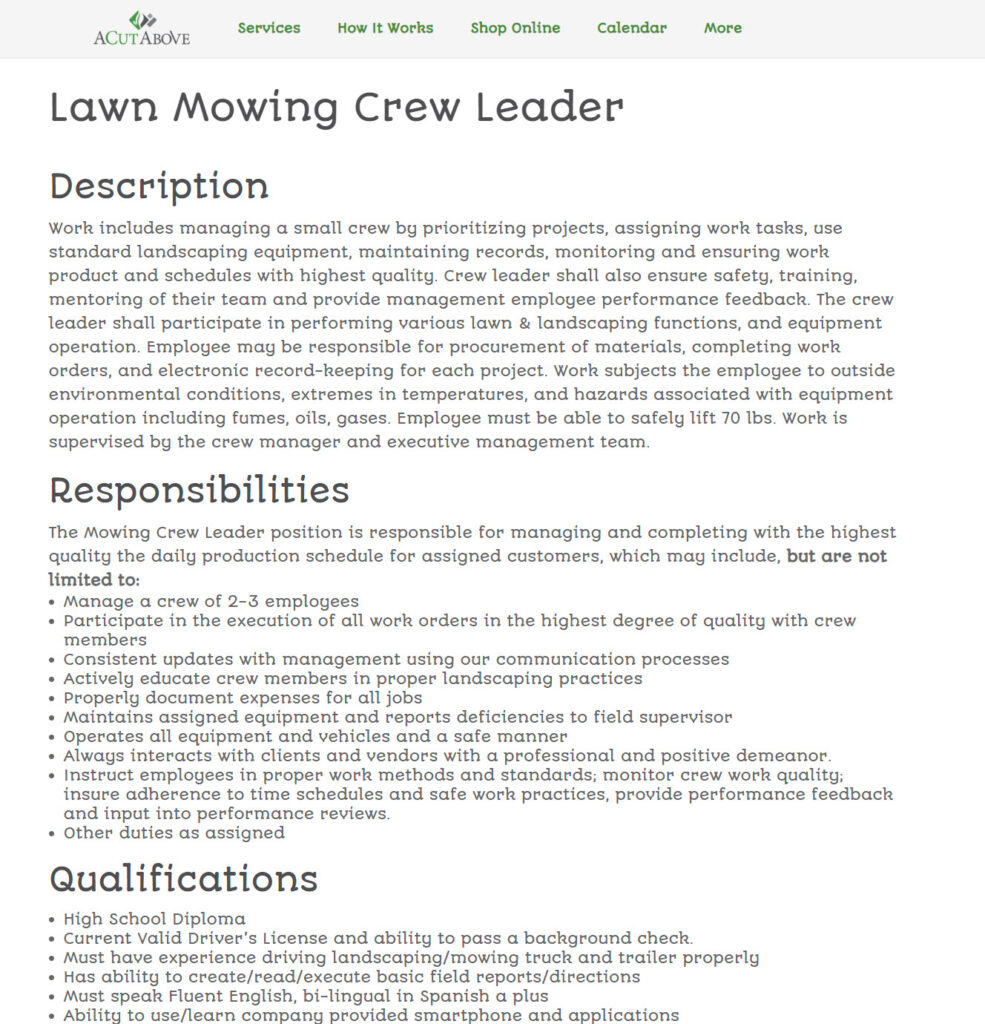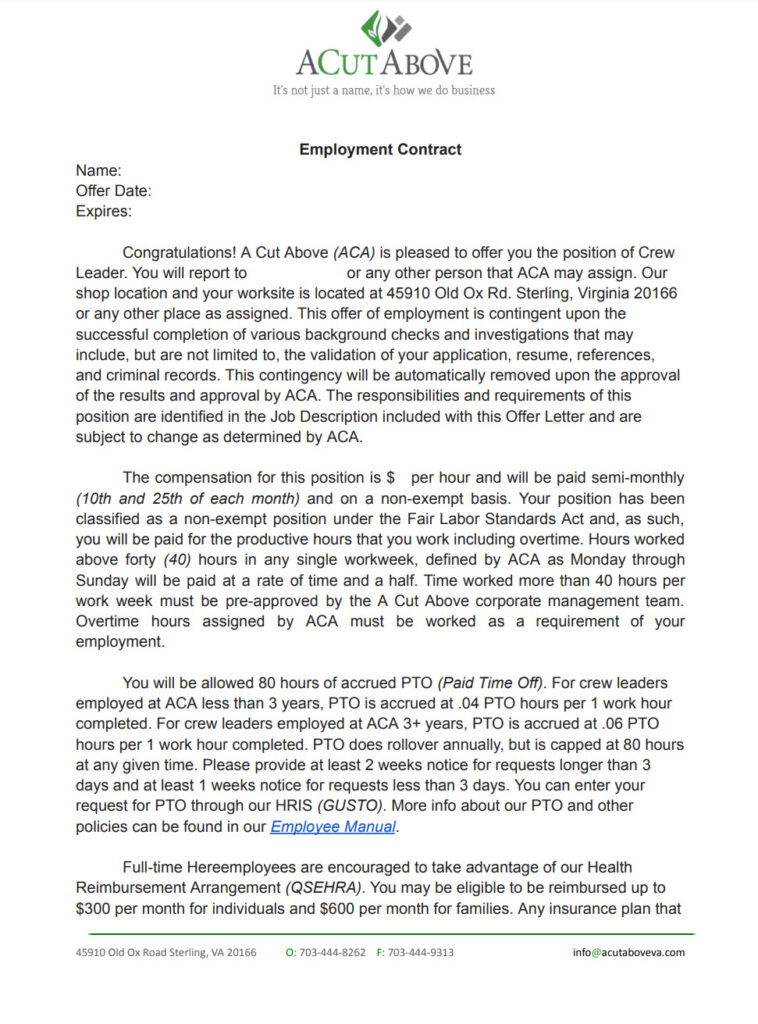Introduction
In the bustling landscape of the service industry, the pillars of clarity and transparency are not just desirable—they are essential. As business owners and managers navigate the intricate dynamics of running a service-oriented business, understanding the profound impact of well-crafted job descriptions and meticulously drafted employee contracts becomes paramount. This blog post delves into the heart of these critical elements, unraveling the hows and whys of setting up job descriptions and employee contracts that not only meet legal requirements but also foster a thriving work environment.
The foundation of any successful service business lies in its people, and the first step to ensuring a harmonious employer-employee relationship is through clear communication of roles and expectations. Job descriptions serve as a roadmap, guiding both potential and current employees through the daily expectations and responsibilities of their roles. They are the silent narrators that articulate the needs and goals of your business, enabling candidates and staff to align their skills and aspirations with the company’s vision.
Meanwhile, employee contracts are the binding agreements that seal this understanding into a formal commitment. These documents are crucial in laying down the terms of employment, encompassing everything from job responsibilities and compensation to workplace policies and termination conditions. The meticulous crafting of these contracts not only safeguards the business legally but also sets a tone of mutual respect and clarity between the employer and the employee.
As we journey through this post, we will explore the intricacies of creating effective job descriptions and robust employee contracts. Our aim is to provide you with the insights and tools needed to create a transparent and efficient work environment, where expectations are clear, and every team member is empowered to contribute to the success of your service business.
The Importance of Job Descriptions
In the realm of service businesses, the cornerstone of a well-oiled workforce lies in the clarity and precision of job descriptions. These documents do more than just list duties and requirements; they serve as a critical communication tool that bridges the gap between an employer’s expectations and an employee’s performance. Let’s dive into why job descriptions are indispensable and how they can be crafted to maximize their effectiveness.
Understanding the Role of Job Descriptions
At its core, a job description acts as a foundational document that outlines the primary duties, responsibilities, and qualifications required for a specific role. But its importance extends beyond these basics. It sets the stage for an employee’s career journey within your organization, providing a clear outline of what is expected day in and day out. This clarity is crucial not just for potential candidates, who can gauge whether their skills and career aspirations align with the role, but also for current employees, who need a clear understanding of their responsibilities to succeed.
Moreover, job descriptions play a vital role in organizational structure and planning. They help in identifying skill gaps, planning for future hiring, and ensuring that each role is aligned with the company’s strategic goals. When employees understand how their roles contribute to the larger objectives of the business, they are more likely to feel engaged and motivated.
Crafting Effective Job Descriptions
So, how does one create a job description that is both clear and comprehensive? Start by ensuring that each description includes the job title, a summary of the role, a detailed list of duties and responsibilities, required qualifications (such as education and experience), and any necessary skills or competencies. It’s important to be specific yet concise, avoiding jargon that might confuse or alienate potential applicants.
Remember, an effective job description is not just a list; it’s a reflection of your company’s culture and values. Use it as an opportunity to showcase what makes your organization unique and appealing. Whether it’s your commitment to innovation, your supportive team environment, or your dedication to customer service excellence, let these values shine through in the language and tone of your descriptions.
Aligning Job Descriptions with Business Goals
Aligning job descriptions with your business goals is essential. They should not exist in a vacuum but rather be an integral part of your business strategy. This alignment ensures that every role contributes to the overarching objectives of your organization, whether it’s enhancing customer satisfaction, driving sales, or innovating services. Regularly revisiting and updating job descriptions is also crucial, as this ensures they remain relevant and aligned with the evolving needs and goals of your business.
In sum, well-crafted job descriptions are more than administrative formalities; they are strategic tools that can significantly impact the efficiency and success of your service business. By investing time and effort into creating detailed and aligned job descriptions, you lay a solid foundation for clear communication, employee engagement, and overall organizational effectiveness.
Sample Job Description Template
Service Business Owners, streamline your hiring process! Click here to access a tailored job description template for the service sector. It’s the perfect tool to help you define roles and attract the right candidates efficiently.
Defining the Role and Power of Employee Contracts
Just as a ship relies on its anchor for stability, a service business finds its steadiness through well-structured employee contracts. These contracts do more than just formalize the employment relationship; they are a mutual agreement that lays down the expectations and responsibilities of both the employer and the employee. Let’s explore the key components that make these contracts so vital.
Key Components of an Employee Contract
- Job Description Alignment: The contract should start with a clear reference to the job description, ensuring that the role’s duties and expectations are well-defined.
- Compensation and Benefits: Clearly outline salary, wage structure, and any benefits, including health insurance, retirement plans, and vacation policies.
- Work Hours and Location: Specify the working hours, any expectations of overtime, and whether the role is in-office, remote, or hybrid.
- Confidentiality Agreements: Protect your business’s sensitive information with confidentiality clauses.
- Termination Conditions: Clearly state the terms under which the contract can be terminated by either party, including notice periods and any severance arrangements.
Legal Considerations and Compliance
It is crucial to ensure that your employee contracts are not just comprehensive, but also legally sound and compliant with labor laws. This involves:
- Understanding Local and Federal Laws: Be aware of the legal requirements in your jurisdiction, including minimum wage laws, overtime rules, and employment discrimination laws.
- Customization to Business Needs: While templates can be a starting point, customize your contracts to reflect the unique aspects of your business and industry.
- Legal Review: Consider having a legal expert review your contracts to ensure they meet all regulatory requirements and best protect your business interests.
Negotiating and Finalizing Contracts
The final stage is about reaching an agreement that is fair and acceptable to both parties.
- Open Dialogue: Encourage open communication during contract negotiations. This sets a positive tone for the employer-employee relationship.
- Clarity and Understanding: Ensure that the employee fully understands the contract terms. This might involve explaining legal jargon or complex clauses.
- Signing and Storage: Once agreed upon, ensure that contracts are signed by both parties and securely stored for future reference.
The Power of a Well-Crafted Contract
A well-crafted employee contract does more than fulfill a legal requirement; it builds a foundation of trust and clarity. It’s a tool that, when used effectively, can foster a positive work environment, reduce misunderstandings, and create a strong, unified team ready to drive your service business forward.
DOWNLOAD YOUR SAMPLE EMPLOYEE CONTRACT
Attention Service Business Owners! Click below to view a sample employee contract. This template offers a practical reference for drafting your own agreements, ensuring compliance and clarity in your employment terms.
Implementing and Updating Documentation
The Essence of Implementation
- Integrating into Recruitment & Onboarding
- Recruitment: Use job descriptions as a blueprint to attract candidates whose skills align with your needs.
- Onboarding: Establish clear role expectations for new hires using these documents.
- Embedding in Daily Operations
- Performance Reviews: Utilize job descriptions to assess employee performance and growth areas.
- Role Changes and Disputes: Refer to employee contracts to ensure decisions are aligned with agreed terms.
The Art of Keeping Documentation Current
- Regular Revisions for Relevance
- Job Roles: Adapt descriptions to new technologies or business strategies.
- Contract Updates: Modify contracts to comply with evolving labor laws.
- Collaborative Approach to Updates
- Stakeholder Involvement: Involve department heads and employees in the update process.
- Fostering Inclusion and Respect: Use updates as an opportunity to reinforce a positive company culture.
Implementing and updating job descriptions and employee contracts are not just administrative tasks; they are strategic actions that breathe life into these documents. By embedding them into your business’s recruitment, onboarding, and daily operations, you ensure that they serve as active guides and benchmarks for your team. Furthermore, regular updates to these documents, done collaboratively, keep them relevant and effective. This approach not only aligns with your evolving business needs but also fosters a workplace environment where clarity, inclusion, and respect are paramount. Thus, these documents become more than just paperwork; they are integral components of your business’s success story.
Case Study: Transformation at “A Cut Above”
For nearly a decade, “A Cut Above,” a burgeoning service company, grappled with a myriad of employee-related issues that threatened its stability and growth. The root of these challenges lay hidden in their unstructured approach to hiring and managing their workforce. This case study sheds light on how the implementation of structured job descriptions and employee contracts revolutionized their business operations.
Identifying the Core Issues
The initial diagnosis revealed a glaring absence of formal processes in hiring. The lack of clear job descriptions led to the recruitment of unqualified candidates, while the absence of formal employee contracts resulted in frequent conflicts over expectations and roles. This unstructured approach created an environment rife with misunderstandings and inefficiencies, stunting the company’s growth and morale.
Implementing Structured Processes
Recognizing these issues, “A Cut Above” embarked on a journey to redefine its hiring and management processes. The first step was the development of precise job descriptions. These documents provided a clear framework for the qualifications and responsibilities required for each role, ensuring that only suitable candidates were considered. The clarity these descriptions brought to the hiring process was transformative, leading to a more competent and aligned workforce.
Simultaneously, the introduction of formal employee contracts established a solid foundation for the employer-employee relationship. These contracts laid out the terms of employment, performance expectations, and workplace policies clearly and concisely. This transparency in expectations and obligations fostered a culture of trust and mutual respect, crucial for any thriving business environment.
The Outcome: A Flourishing Business and Culture
The impact of these changes was profound. “A Cut Above” not only expanded its team to over 35 full-time employees, but it also cultivated a healthy, transparent culture. The clarity and structure provided by the job descriptions and employee contracts enhanced team coherence, reduced conflicts, and improved overall efficiency. Today, “A Cut Above” stands as a testament to the transformative power of well-defined employment processes, highlighting how structured approaches can turn challenges into opportunities for growth and success.
Fostering a Transparent Work Environment
Principles of Transparency
- 1. Open Communication: Cultivate an environment where open, honest communication is the norm, not the exception.
- 2. Mutual Respect: Encourage interactions rooted in respect, understanding that clear expectations from both job descriptions and contracts foster this culture.
Implementing Transparency in Daily Operations
- 1. Regular Feedback: Establish channels for consistent and constructive feedback, aligning with the roles and responsibilities outlined in job descriptions.
- 2. Transparency in Decision-Making: Involve team members in decisions that affect their work, referencing the expectations and agreements laid out in their contracts.
Benefits of a Transparent Culture
- 1. Enhanced Trust: A transparent work environment builds trust, leading to a more engaged and committed workforce.
- 2. Clarity and Alignment: Clear understanding of roles and expectations leads to better alignment with company goals and reduced conflicts.
Challenges and Solutions
- 1. Overcoming Resistance: Address resistance to transparency by demonstrating its value in improving workflow and job satisfaction.
- 2. Maintaining Consistency: Ensure that transparency is not just a one-off initiative but a consistent practice in every aspect of your business operations.
In fostering a transparent work environment, it’s crucial to establish a culture where open communication and mutual respect are integral. By implementing regular feedback mechanisms and involving employees in decision-making processes, you reinforce the principles outlined in their job descriptions and contracts. This approach not only enhances trust but also ensures clarity and alignment with the company’s objectives.
However, creating such an environment is not without its challenges. Resistance to change is natural, but it can be overcome by demonstrating the tangible benefits of a transparent culture. Consistency is key — make transparency a core part of your business ethos, not just a fleeting initiative. By doing so, you not only build a more cohesive and motivated team but also lay the groundwork for long-term success and stability in your service business.
Embracing Clarity for a Brighter Future
As we conclude this exploration into the critical realms of job descriptions and employee contracts, it’s evident that these are not mere administrative tasks, but powerful tools in shaping the culture and success of your service business. “A Cut Above” serves as a shining example of how structured processes and clear communication can transform challenges into opportunities for growth and prosperity.
Embracing clarity in every facet of your business operations, from hiring to daily management, paves the way for a thriving work environment. It cultivates a space where expectations are clear, communication is open, and every team member is aligned with the company’s vision. This is the kind of workplace that not only attracts top talent but also retains them, fostering a sense of belonging and commitment.
Remember, the journey towards a transparent and efficient workplace is ongoing. It requires regular reflection, adaptation, and a willingness to embrace new ideas and practices. As your business evolves, so too should your approach to job descriptions, employee contracts, and overall communication strategies.
In this dynamic world, one thing remains constant: the value of clarity. It’s the beacon that guides your team through challenges, the foundation upon which trust is built, and the force that drives your business forward. So, as you move ahead, carry with you the lessons and insights shared in this post. Implement them, adapt them, and watch as they illuminate the path to a brighter, more successful future for your service business.
We invite you to share your experiences and thoughts. How have clear job descriptions and contracts shaped your business? What strategies have you found effective in maintaining a transparent work environment? Your insights are valuable, and together, we can continue to learn, grow, and excel in the ever-evolving landscape of the service industry.
Elevate Your Business with Smart Pricing Solutions!
Dive into a new era of business efficiency with our A Cut Above Software Applications. If you’re eager to systematize your operations, our Gross Margin Pricing Calculator Application is the perfect starting point. Tailor-made for the savvy small business owner, this application is your key to swift, precise job cost calculations. Enhance your pricing strategies effortlessly and boost your profitability. Don’t let this chance slip away! Click the button, download our application, and begin your journey to smarter, more efficient business management today.





